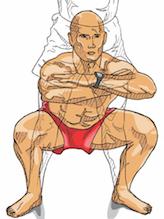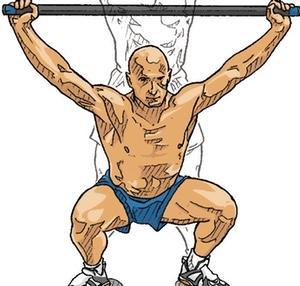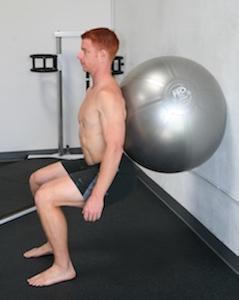You Should Squat! Part 2
by Paul Chek

One of the most important Primal Pattern® movements that is critical to optimal human functioning is the squat.
In part one of our series, I showed you how to perform the squat safely, correctly and with greater ease or difficulty depending on your condition, because when it comes to squatting, if you can’t, you must!
There are other critical reasons why you must be able to perform a squat properly which are tied to human digestion and the elimination of waste.
Squatting: Good for Your Insides
Humans are the only animals who must push feces up hill, due to the anatomy of their colons. (Figure 5) In native people who squat to work, socialize or defecate, it is natural to squat down until their hands reach the ground or until the torso is fully relaxed and supported by their thighs (Figure 6).
Such a full squat results in the thigh compressing the lower abdomen. Then, the right thigh will compress the cecum (the origin of the colon), mechanically pushing the feces uphill into the transverse colon, while the left thigh compresses the descending colon, moving feces into the sigmoid colon and, ultimately, the rectum.
With this in mind, it is not surprising that many early naturopathic physicians attributed the massive increase in constipation in the late 1800s and early 1900s to Thomas Crapper, the plumber who popularized the toilet (but didn’t actually invent it!).
The modern toilet doesn’t require a full squat, therefore it doesn’t facilitate evacuation of the colon. With chronic constipation, the entire system gets backed up literally from the stomach to the anus. The stomach is forced to hold onto its contents, often leading to reflux, heartburn and poor digestion.
To combat this, colon hygienists recommend the use of a footstool ranging from 6-14 inches tall, placed on the floor in front of the toilet. The addition of the full squat to your exercise program, along with a footstool, can dramatically improve digestion and elimination.
The full squat also helps digestion and elimination due to pressure changes in the abdominal and thoracic cavities and the improved motility of organs.
Whenever you repeatedly perform the full squat, a pressure wave is created by the thighs, compressing the abdominal viscera, and by the action of the diaphragm as you breathe.
This pressure wave, coupled with the mechanical action of the thighs, literally mobilizes the viscera and pumps blood and lymphatic fluids as well as mechanically aiding the intestinal system.
Breathing Squats for Improved Digestion
By learning how to perform breathing squats, you can facilitate the parasympathetic nervous system (PNS), which is also called the anabolic or digestive nervous system because it regulates these activities.
Implementing PNS stimulating activities like breathing squats are more important today than ever before. Why? Not only is modern life stressful, we are eating a tremendous amount of processed foods that contain sympathetic nervous system (SNS) stimulants.
Caffeinated foods, sugary beverages and many processed foods in general are powerful stimulators of the SNS, which act as the functional antagonist to the PNS. Too much SNS activity results in poor recovery from exercise, bad digestion and limited elimination!
With those problems in mind, here’s six steps it takes to perform breathing squats safely and properly (Figure 7):
- Standing with good upright posture, take a deep belly breath and simply begin the squat from the hip, lowering yourself as far as possible (no load on the body!) or until your torso rests on your thighs.
- As you lower your body, slowly release the air through your nose. Take four seconds to lower your body as you breathe out.
- At the bottom of the squat (torso resting on thighs if you can), pause for a second and begin inhaling through your nose.
- Make sure that you rise for four seconds, with a brief pause at the top, before breathing in as you lower for the next four counts.
- As you become more efficient, slow the squat time down to six, or even eight seconds. Slower squats will be even more energizing to the body, as slow movements allow chi (also called Prana or life-force energy) to move faster throughout the body.
- Try starting your day with a few minutes of breathing squats and build up to as many as 100 in a row. Progress slowly so you don’t get muscle soreness and do them in a quiet area where you can relax and focus on your breathing. In just a few days, you will notice improved vitality and you may find your bowel habits improving too!
Versatility of the Squat
The squat is a movement pattern that has enormous functional carryover to everyday work and sports activities. Plus, it can be used to improve digestion and elimination, which is a definite benefit nowadays with the increased amount of antacids and reflux drugs many people take!
If you do not squat regularly, start with the breathing squats to develop proficiency in the squat movement pattern. Then, you can try squats with an additional load, to develop strength and stamina.
Whatever you do, don’t ignore the squat just because it feels uncomfortable! Find a qualified person, such as a C.H.E.K Institute-trained professional, and have them coach you in the correct technique, so that you can avoid future injuries when you absolutely have to squat.
Love and chi,
Paul
(Note: Want to learn when and how to use the squat for maximal benefit? Take our Scientific Back Training correspondence course now and save up to 40%.)
[layerslider id=”1″]





